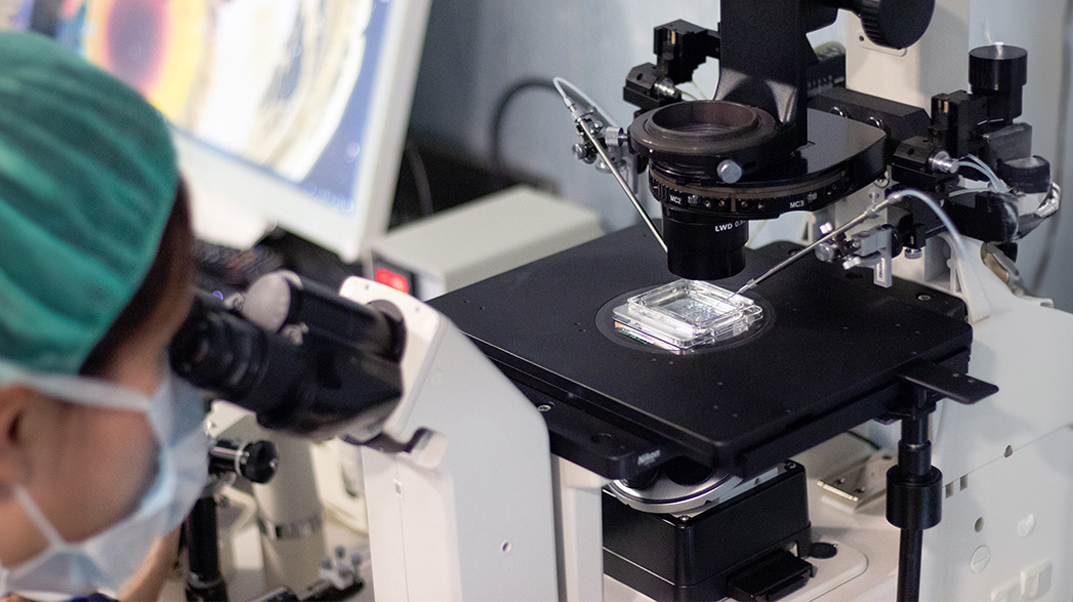Table of contents
Implantation failures and recurrent miscarriages account for 10-20% of failed IVF treatments
At Tambre we are constantly innovating and improving our treatments in order to achieve the shared goal of pregnancy and the birth of a healthy baby. Hence, we have just added an innovative culture medium to the in vitro fertilisation laboratory that supports early embryo nutrition and development, which can increase implantation rates.
The implantation process
The implantation process is crucial to the success of any fertility treatment. The embryo must properly attach to the endometrium –the lining of the uterus– in order to further develop and achieve a successful pregnancy. However, some embryos face difficulties in achieving this implantation during treatment.
Looking for ways to improve the conditions in which embryos are cultured prior to transfer is essential to address these challenges. Optimising the embryo environment can potentially be the difference between success and failure in fertility treatments. With this goal in mind, we have adopted an innovative culture medium that offers new hope for the most difficult cases by using a cytokine that helps regulate the production and function of immune cells.
This culture medium offers hope in particularly complicated cases. Between 20-30% of failed IVF treatments are associated with implantation failure, i.e., the embryo is unable to get implanted in the uterus. And 10-15% of women who undergo IVF suffer recurrent miscarriages (3 or more gestational losses). This medium, whose scientific name is SAGE 1-Step GM-CSF, is composed of a cytokine to improve embryo viability and increase implantation rates and helps us to increase the pregnancy rate in women with implantation failure by up to 40%.
What is it?
SAGE 1-Step GM-CSF is a state-of-the-art culture medium developed by CooperSurgical that uses Granulocyte-Macrophage Colony Stimulating Factor (GM-CSF), a cytokine that acts as a special ‘nutrient’ for embryos: facilitates embryo growth and development, increases blastocyst formation rates and improves the overall quality of cultured embryos and, potentially, pregnancy rates. Recent studies have shown that the use of this medium increases the chances of successful implantation in the uterus. This culture medium supports early embryo nutrition and development, which can increase implantation rates. And there have been excellent results: In women suffering from recurrent implantation failure (RIF), the pregnancy rate using this culture medium reaches 40% compared to 28% of pregnancies achieved without this innovative medium. And in patients with previous miscarriages the implantation rate is more than 23%, and the live birth rate increases by 6%.
Benefits for patients with difficult cases
As mentioned above, the inclusion of this new medium in our laboratory is especially intended to help patients who have experienced previous implantation failures, repeated miscarriages or who have difficulties in reaching the blastocyst stage in the first cycle of treatment. This culture medium can be used in subsequent cycles to improve the chances of embryo development and successful implantation.
This medium represents a valuable tool for improving outcomes in complex fertility treatments. We are excited about the possibilities it offers and expect it to make a significant difference for our patients
Commitment to excellence
At Tambre, our commitment to excellence and innovation is unwavering. This new development is a reflection of our ongoing efforts to provide our patients with the best opportunities to achieve success in their fertility treatments. In addition, we are conducting extensive studies to assess the effectiveness of this culture medium in different contexts and with different patient profiles, thus ensuring the best possible application.
Optimising embryo implantation is a pivotal aspect of fertility treatments, and by incorporating this cytokine-based medium, Tambre is offering new hope for challenging cases. This innovative tool is a significant advance in the field of assisted reproduction, giving our patients an additional opportunity to achieve the dream of parenthood.


